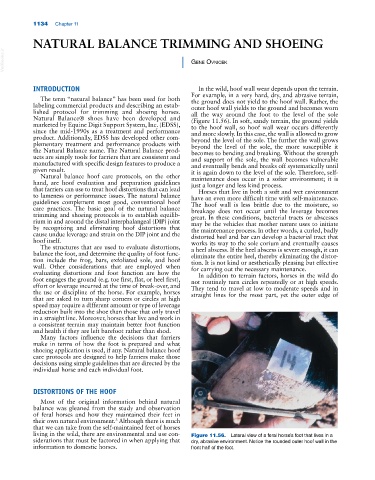Page 1168 - Adams and Stashak's Lameness in Horses, 7th Edition
P. 1168
1134 Chapter 11
NATURAL BALANCE TRIMMING AND SHOEING
VetBooks.ir Gene Ovnicek
INTRODUCTION In the wild, hoof wall wear depends upon the terrain.
For example, in a very hard, dry, and abrasive terrain,
The term “natural balance” has been used for both the ground does not yield to the hoof wall. Rather, the
labeling commercial products and describing an estab outer hoof wall yields to the ground and becomes worn
lished protocol for trimming and shoeing horses. all the way around the foot to the level of the sole
Natural Balance® shoes have been developed and (Figure 11.56). In soft, sandy terrain, the ground yields
marketed by Equine Digit Support System, Inc. (EDSS), to the hoof wall, so hoof wall wear occurs differently
since the mid‐1990s as a treatment and performance and more slowly. In this case, the wall is allowed to grow
product. Additionally, EDSS has developed other com beyond the level of the sole. The further the wall grows
plementary treatment and performance products with beyond the level of the sole, the more susceptible it
the Natural Balance name. The Natural Balance prod becomes to bending and breaking. Without the strength
ucts are simply tools for farriers that are consistent and and support of the sole, the wall becomes vulnerable
manufactured with specific design features to produce a and eventually bends and breaks off systematically until
given result. it is again down to the level of the sole. Therefore, self‐
Natural balance hoof care protocols, on the other maintenance does occur in a softer environment; it is
hand, are hoof evaluation and preparation guidelines just a longer and less kind process.
that farriers can use to treat hoof distortions that can lead Horses that live in both a soft and wet environment
to lameness or performance issues. The natural balance have an even more difficult time with self‐maintenance.
guidelines complement most good, conventional hoof The hoof wall is less brittle due to the moisture, so
care practices. The basic goal of the natural balance breakage does not occur until the leverage becomes
trimming and shoeing protocols is to establish equilib great. In these conditions, bacterial tracts or abscesses
rium in and around the distal interphalangeal (DIP) joint may be the vehicles that mother nature uses to initiate
by recognizing and eliminating hoof distortions that the maintenance process. In other words, a curled, badly
cause undue leverage and strain on the DIP joint and the distorted heel and bar can develop a bacterial tract that
hoof itself. works its way to the sole corium and eventually causes
The structures that are used to evaluate distortions, a heel abscess. If the heel abscess is severe enough, it can
balance the foot, and determine the quality of foot func eliminate the entire heel, thereby eliminating the distor
tion include the frog, bars, exfoliated sole, and hoof tion. It is not kind or aesthetically pleasing but effective
wall. Other considerations that are employed when for carrying out the necessary maintenance.
evaluating distortions and foot function are how the In addition to terrain factors, horses in the wild do
foot engages the ground (e.g. toe first, flat, or heel first), not routinely turn circles repeatedly or at high speeds.
effort or leverage incurred at the time of break‐over, and They tend to travel at low to moderate speeds and in
the use or discipline of the horse. For example, horses straight lines for the most part, yet the outer edge of
that are asked to turn sharp corners or circles at high
speed may require a different amount or type of leverage
reduction built into the shoe than those that only travel
in a straight line. Moreover, horses that live and work in
a consistent terrain may maintain better foot function
and health if they are left barefoot rather than shod.
Many factors influence the decisions that farriers
make in terms of how the foot is prepared and what
shoeing application is used, if any. Natural balance hoof
care protocols are designed to help farriers make those
decisions using simple guidelines that are directed by the
individual horse and each individual foot.
DISTORTIONS OF THE HOOF
Most of the original information behind natural
balance was gleaned from the study and observation
of feral horses and how they maintained their feet in
their own natural environment. Although there is much
3
that we can take from the self‐maintained feet of horses
living in the wild, there are environmental and use con Figure 11.56. Lateral view of a feral horse’s foot that lives in a
siderations that must be factored in when applying that dry, abrasive environment. Notice the rounded outer hoof wall in the
information to domestic horses. front half of the foot.

